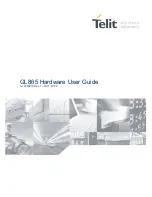
LENA-R8 series - System integration manual
UBX-22015376 - R02
Handling and soldering
Page 98 of 116
C1-Public
3
Handling and soldering
☞
No natural rubbers, no hygroscopic materials or materials containing asbestos are employed.
3.1
Packaging, shipping, storage, and moisture preconditioning
For information pertaining to LENA-R8 series reels / tapes, Moisture Sensitivity levels (MSD),
shipment and storage information, as well as drying for preconditioning, see the LENA-R8 series data
sheet
and the u-blox package information user guide
3.2
Handling
The LENA-R8 series modules are Electro-Static Discharge (ESD) sensitive devices.
⚠
Ensure ESD precautions are implemented during handling of the module.
Electrostatic discharge (ESD) is the sudden and momentary electric current that flows between two
objects at different electrical potentials caused by direct contact or induced by an electrostatic field.
The term is usually used in the electronics and other industries to describe momentary unwanted
currents that may cause damage to electronic equipment.
The ESD sensitivity for each pin of the LENA-R8 series modules (as Human Body Model according to
JESD22-A114F) is specified in the LENA-R8 series data sheet
ESD prevention is based on establishing an Electrostatic Protective Area (EPA). The EPA can be a
small working station or a large manufacturing area. The main principle of an EPA is that there are no
highly charging materials near ESD sensitive electronics, all conductive materials are grounded,
workers are grounded, and charge build-up on ESD sensitive electronics is prevented. International
standards are used to define typical EPA and can be obtained for example from International
Electrotechnical Commission (IEC) or American National Standards Institute (ANSI).
In addition to standard ESD safety practices, the following measures should be taken into account
whenever handling the LENA-R8 series modules:
•
Unless there is a galvanic coupling between the local GND (i.e. the work table) and the PCB GND,
then the first point of contact when handling the PCB must always be between the local GND and
PCB GND.
•
Before mounting an antenna patch, connect the ground of the device.
•
When handling the module, do not come into contact with any charged capacitors and be careful
when contacting materials that can develop charges, e.g. patch antenna, coax cable, soldering
iron, etc..
•
To prevent electrostatic discharge through the RF pin, do not touch any exposed antenna area. If
there is any risk that such exposed antenna area is touched in a non-ESD protected work area,
implement proper ESD protection measures in the design.
•
When soldering the module and patch antennas to the RF pin, make sure to use an ESD safe
soldering iron.














































